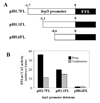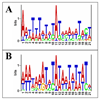An enhancer-like region regulates hrp3 promoter stage-specific gene expression in the human malaria parasite Plasmodium falciparum
- PMID: 17570541
- PMCID: PMC2267920
- DOI: 10.1016/j.bbaexp.2007.04.009
An enhancer-like region regulates hrp3 promoter stage-specific gene expression in the human malaria parasite Plasmodium falciparum
Abstract
The asexual blood stage of Plasmodium falciparum is comprised of morphologically distinct ring, trophozoite and schizont stages. Each of these developmental stages possesses a distinct pattern of gene expression. Regulation of P. falciparum gene expression is thought to occur, at least in part, at the promoter level. Previously, we have found that although the hrp3 mRNA is only seen in ring-stage parasites, deletion of a specific sequence in the 5' end of the promoter region decreased ring-stage expression of hrp3 and enabled detection of its transcripts in trophozoite-stage parasites. In order to investigate this stage specific regulation of gene expression, we employed a series of nested deletions of the 1.7-kb hrp3 promoter. Firefly luciferase gene was used as a reporter to evaluate the role of promoter sequences in gene regulation. Using this approach, we identified a ring-stage specific regulatory region on the hrp3 promoter located between -1.7 kb and -1.1 kb from the ATG initiation codon. Small 100-150 bp truncations on this enhancer-like region failed to uncover discrete regulatory sequences, suggesting the multipartite nature of this element. The data presented in this study demonstrate that stage specific promoter activity of the hrp3 gene in P. falciparum blood stage parasites is supported, at least in-part, by a small promoter region that can function in the absence of a larger chromosomal context.
Figures





Similar articles
-
Plasmodium falciparum: hrp3 promoter region is associated with stage-specificity and episomal recombination.Exp Parasitol. 2007 Jul;116(3):327-33. doi: 10.1016/j.exppara.2007.01.020. Epub 2007 Feb 4. Exp Parasitol. 2007. PMID: 17367782 Free PMC article.
-
Role of cis-regulatory elements on the ring-specific hrp3 promoter in the human parasite Plasmodium falciparum.Parasitol Res. 2010 Mar;106(4):833-45. doi: 10.1007/s00436-010-1738-9. Epub 2010 Feb 3. Parasitol Res. 2010. PMID: 20127361
-
HRP2 and HRP3 cross-reactivity and implications for HRP2-based RDT use in regions with Plasmodium falciparum hrp2 gene deletions.Malar J. 2021 Apr 29;20(1):207. doi: 10.1186/s12936-021-03739-6. Malar J. 2021. PMID: 33926477 Free PMC article.
-
Assessing the histidine-rich protein 2/3 gene deletion in Plasmodium falciparum isolates from Burkina Faso.Malar J. 2023 Nov 29;22(1):363. doi: 10.1186/s12936-023-04796-9. Malar J. 2023. PMID: 38017455 Free PMC article.
-
Plasmodium falciparum parasites lacking histidine-rich protein 2 and 3: a review and recommendations for accurate reporting.Malar J. 2014 Jul 22;13:283. doi: 10.1186/1475-2875-13-283. Malar J. 2014. PMID: 25052298 Free PMC article. Review.
Cited by
-
Analysis of the molecular mechanisms governing the stage-specific expression of a prototypical housekeeping gene during intraerythrocytic development of P. falciparum.J Mol Biol. 2011 Apr 29;408(2):205-21. doi: 10.1016/j.jmb.2011.02.043. Epub 2011 Feb 24. J Mol Biol. 2011. PMID: 21354176 Free PMC article.
-
A var gene promoter implicated in severe malaria nucleates silencing and is regulated by 3' untranslated region and intronic cis-elements.Int J Parasitol. 2009 Nov;39(13):1425-39. doi: 10.1016/j.ijpara.2009.05.001. Epub 2009 May 20. Int J Parasitol. 2009. PMID: 19463825 Free PMC article.
-
Patterns of gene-specific and total transcriptional activity during the Plasmodium falciparum intraerythrocytic developmental cycle.Eukaryot Cell. 2009 Mar;8(3):327-38. doi: 10.1128/EC.00340-08. Epub 2009 Jan 16. Eukaryot Cell. 2009. PMID: 19151330 Free PMC article.
-
Genome-wide identification of novel intergenic enhancer-like elements: implications in the regulation of transcription in Plasmodium falciparum.BMC Genomics. 2017 Aug 23;18(1):656. doi: 10.1186/s12864-017-4052-4. BMC Genomics. 2017. PMID: 28836940 Free PMC article.
-
Histone modifications associated with gene expression and genome accessibility are dynamically enriched at Plasmodium falciparum regulatory sequences.Epigenetics Chromatin. 2020 Nov 23;13(1):50. doi: 10.1186/s13072-020-00365-5. Epigenetics Chromatin. 2020. PMID: 33225957 Free PMC article.
References
-
- Global. WHO declares emergency against AIDS, TB, malaria. AIDS policy & law. 2006;21:5. - PubMed
-
- Simooya O. The WHO 'Roll Back Malaria Project': planning for adverse event monitoring in Africa. Drug Saf. 2005;28:277–286. - PubMed
-
- Wesseling JG, Snijders PJ, van Someren P, Jansen J, Smits MA, Schoenmakers JG. Stage-specific expression and genomic organization of the actin genes of the malaria parasite Plasmodium falciparum. Mol Biochem Parasitol. 1989;35:167–176. - PubMed
-
- Waters AP, Syin C, McCutchan TF. Developmental regulation of stage-specific ribosome populations in Plasmodium. Nature. 1989;342:438–440. - PubMed
-
- Waters AP. The ribosomal RNA genes of Plasmodium. Adv Parasitol. 1994;34:33–79. - PubMed
Publication types
MeSH terms
Substances
Grants and funding
LinkOut - more resources
Full Text Sources

